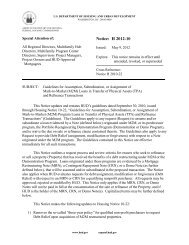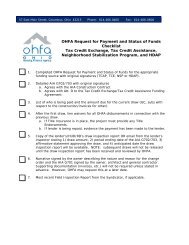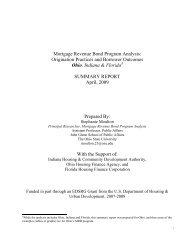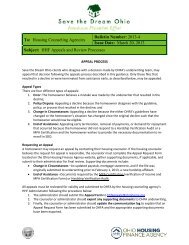lis 217 stemming the tide - LISC
lis 217 stemming the tide - LISC
lis 217 stemming the tide - LISC
- No tags were found...
Create successful ePaper yourself
Turn your PDF publications into a flip-book with our unique Google optimized e-Paper software.
may construe <strong>the</strong> IRP as an "old and cold"subsidy if it continues to be linked to <strong>the</strong> originalfinancing.EligibilityEligible projects must be assisted under Section236 with insured, HUD-held, or non-insured(HFA) mortgages. Eligible mortgagors includenonprofit, limited dividend, and public entities.Under 236(b), eligible lenders are limited tostate or local public agencies approved by HUD.Under 236(e), eligible lenders may be public orprivate, but a state or local public agency mustprovide regulatory oversight (e.g., IRP subsidyadministration, rent increase processing,inspections, owner compliance monitoring).Alternately, <strong>the</strong> lender must be an FHAapprovedmortgagee, <strong>the</strong> mortgage must beHUD-insured, and HUD must perform regulatoryoversight functions.Rents, Contract Terms, and DistributionsThe IRP assistance continues as a monthly subsidystream for <strong>the</strong> remaining term of <strong>the</strong> 236mortgage, in accordance with <strong>the</strong> original subsidycontract. The monthly IRP subsidy may alsobe reduced and stretched over an extendedcontract term, but <strong>the</strong> monthly and aggregatetotal IRP cannot be increased. The 236regime—including budget-based rents, tenantincome eligibility limits, and o<strong>the</strong>r regulatoryoversight—continues for <strong>the</strong> original mortgageterm, plus five years, pursuant to a new HUDUse Agreement. The owner must also commit torenew any Section 8 contract throughout <strong>the</strong>extended use period if HUD offers a renewalcontract.Rents can be increased on a budget basis tocover debt service on any new financing foracquisition, rehab, or equity takeout. Upon prepaymentof <strong>the</strong> mortgage (under 236(e)) or terminationof <strong>the</strong> HUD mortgage insurance (under236(b)), Enhanced Vouchers are generally providedfor existing eligible tenants who are notcovered by a project-based Section 8 contract. 22Rents are capped at <strong>the</strong> new budget-based 236Basic Rent. Tenants may not be displaced inconjunction with <strong>the</strong> 236(b) or 236(e) transaction.In general, <strong>the</strong> new Section 236 Basic Rent cannotexceed <strong>the</strong> market-comparable rent minus<strong>the</strong> IRP subsidy. Additionally, <strong>the</strong> Basic Rent fornon-Section 8 units may not be increased bymore than 10 percent. For preservation projects(financed under LIHPRHA or ELIHPA), <strong>the</strong> BasicRent for non-Section 8 units may not beincreased in conjunction with <strong>the</strong> transaction,except for operating cost increases.Any Section 8 units in <strong>the</strong> project may bemarked up to comparable market rents, if <strong>the</strong>yare eligible under ei<strong>the</strong>r Mark-Up-to-Market orMark-Up-to-Budget. Again, <strong>the</strong> maximumSection 8 rent is generally <strong>the</strong> market comparablerent less IRP.In <strong>the</strong> past, <strong>the</strong>se rent restrictions created a disincentiveto use decoupling. From a preservationperspective, this result is undesirable sinceIRP retention offers <strong>the</strong> benefit of continuedbudget-based rents and income restrictions foran extended period. The alternatives provideless long term affordability: Mark-Up-to-Marketwithout IRP retention requires only five years ofmandatory affordability, and Section 8 opt-outoffers no affordability benefits beyond currentresidents' tenure.Importantly, HUD now will consider waiving <strong>the</strong>IRP deduction for certain sales transactionswhere <strong>the</strong> project needs significant repairs or islocated in an area with lower market rents, aslong as rents are computed on a budget basis.This waiver is not available for transactionsinvolving equity takeout without a transfer ofownership.In strong markets, this policy change hasenabled nonprofits to combine IRP decouplingwith Mark-Up-to-Market/Budget and to maximizeSection 8 rents at full-market—while keepingnon-Section 8 rents as low as possible.Additionally, it has extended <strong>the</strong> benefits of IRPdecoupling to projects in weaker market areas.Limitations on owner distributions and <strong>the</strong>allowable return on equity that can be includedin <strong>the</strong> budget-based rent are less clear. HUDhas recently clarified that reasonable debt servicecoverage can be included in <strong>the</strong> budgetbasedrent. Based on past experience, reason-14 chapter two: Federal Preservation Tools14
















